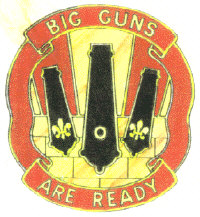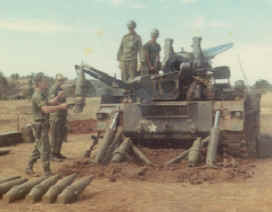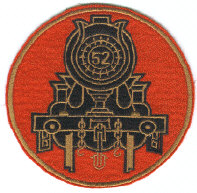52nd ARTILLERY GROUP
Vietnam War

Image
and text credit: Institute of Heraldry
Department of the Army
Distinctive Insignia
Symbolism
Scarlet and yellow (gold) are colors used for Artillery. The three cannon barrels
symbolize the Group's fire power and battle honors Meuse-Argonne, Champagne 1918, World
War I, and service in Vietnam. The masoned wall refers historically to the parent
unit organized in 1917 at Fort Adams, Rhode Island as a coast artillery unit.
52nd Artillery Group (Field Artillery)
"Big Guns Are Ready"
17 June 1966 - 30 June
1971
The following artillery battalions served at one time or another under 52nd Artillery
Group control:
3rd Battalion, 6th Artillery
5th Battalion, 22nd Artillery
7th Battalion, 13th Artillery
1st Battalion, 30th Artillery
6th Battalion, 14th Artillery
6th Battalion, 84th Artillery
7th Battalion, 15th Artillery
1st Battalion, 92nd Artillery
2nd Battalion, 17th Artillery

BIG GUNS WERE READY!
M110 Howitzer ( 8-inch SP ) B Battery
First Field Forces Vietnam
7th Battalion, 15th Field Artillery
RSB Schueller Fall 1971
Photo: ©15th webmaster
|
The
'sound effects department of Pleiku' |
If
anyone has a good sound cassette of artillery fire
of the 1/92nd please contact the 15th
webmaster
|
Bravo
Battery |

6th Battalion
14th Artillery
Loading
175mm
"BRUTE"
November
1965
Photo: Bob Lund
52nd 52nd GROUP%2
STORIES
52d Gp Gets Valorous Award 52nd Group Returns to Fort SillGROUP
STORIES
The following article appeared in the February 25, 1971 Artillery Review newspaper, a publication of I Field Force Vietnam Artillery.
PLEIKU -- By direction of the Secretary of the Army, the
Valorous Unit Citation has been awarded to Headquarters and Headquarters
Battery, 52d Artillery Group, and its assigned and attached units, according to
a recent announcement.
The unit distinction was made in recognition of extraordinary heroism while
engaged in military operations against an armed enemy in the vicinity of Dak To
and Ben Het during the period 4 May 1969 to 28 June 1969.
Other Units Cited
In addition to HHB, 52d Arty Group, the following assigned or attached units
were recognized for their heroic service: 1st Battalion, 92d Artillery; Battery
A, 3d Battalion, 6th Artillery; Battery B, 6th Battalion, 14th Artillery; 2d
Platoon, Battery B, 4th Battalion, 60th Artillery; 1st Platoon, Battery B, 7th
Battalion, 29th Artillery; 2d Section, Battery E, 41st Artillery, 237th Field
Artillery Detachment (Radar) and 254th Field Artillery Detachment (Radar).
Action Commended
In part the citation read: "Demonstrating great personal fortitude and a
firm dedication to mission accomplishment, the officers and men of the battery
succeeded in providing massive quantities of accurately placed artillery fires
in support of manuever operations conducted by Army of the Republic of Vietnam
units against North Vietnamese Army Forces.
"Although often forced to engage in hand to hand conflict with a well
trained and determined foe, the men of HHB, 52d Arty Group continued to perform
their assigned task by placing withering fire upon the enemy. Their
gallant efforts saved the lives of numerous friendly forces, inflicted severe
losses upon their adversary and contributed immeasurably to the successes
achieved in Operation Dan Quyen."
The following story appeared in the August 25, 1971 issue of the Artillery Review newspaper.
52nd Group Returns to Fort Sill
In a continuation of the U.S. troop redeployment from Vietnam, and the down-grading of the U.S. combat role under Vietnamization, the U.S Army's Headquarters Battery, 52nd Artillery Group, has been returned to Fort Sill, Oklahoma, for inactivation. 52nd Group Headquarters thus follows the I Field Force Provisional Artillery Group Headquarters, which was deactivated on March 30th of this year, and with which it shared control of U.S. Artillery units throughout South Vietnam's MRII.
From its headquarters at Artillery Hill in Pleiku, 52nd Group controlled U.S. Artillery of I Field Force Vietnam throughout the Central Highlands and the rest of northern MRII. The numerous battalions it directed backed up its motto "Big Guns are Ready" by providing vital support for the operations of the 1st Cavalry Division, the 25th Infantry Division, the 101st Airborne Division, the 4th Infantry Division, the ROK White Horse and Tiger Divisions, Task Force 19, the 173rd Airborne Brigade, ARVN II Corps, the 22nd and 23rd ARVN Divisions. In all, 52nd Group supported more than 22 major operations, including the Cambodian incursion of 1970 and the more recent battle for Fire Base 6.
The 52nd Artillery Group was organized as the 52nd Artillery Regiment, and was assigned to France during World War 1. In 1924 the regiment was redesignated as the 52nd Artillery Regiment (Railway), but was disbanded in June 1943. In June of 1950 it was reactivated as the 52nd Artillery Group and stationed at Fort Sill, Oklahoma, where it activated and trained units for world-wide deployment of the huge 280mm "Atomic Artillery" weapon. In 1954 it received additional units of the Self-Propelled 762mm Rocket "Honest John".
During the initial Vietnam buildup in early 1966, Headquarters and Headquarters Battery, 52nd Artillery Group, left Fort Sill for Fort Lewis, Washington. In June of that year, the officers and men of the group boarded the USS WALKER for the trip to Vietnam, landing at Qui Nhon on June 17, 1966.
52nd Group's commander at the time of stand-down was Colonel James M. Wroth, who accepted, on behalf of the unit, the Meritorious Unit Commendation and the Vietnamese Valorous Unit Award. Colonel Wroth also received the Legion of Merit and the Air Medal for his efforts as Group commander.
The unit was reduced in-country to a two man color guard, composed of Major Edgar E. Wiseman and CSM Clarence J. Martin, who will return the unit's standard to Fort Sill. CSM Martin, then in his first Vietnam tour, also escorted the unit's colors when they entered Vietnam in 1966. Other personnel of the unit have been reassigned within the Republic or returned to CONUS under normal stand-down criteria. Approximately 109 space reductions were involved.
 Railway Coast Artillery
Railway Coast Artillery
Patch
from WW-1
INDEX OF PAGES
FIRST
FIELD FORCE VIETNAM ARTILLERY
SECOND
FIELD FORCE VIETNAM ARTILLERY
XXIV Corps Artillery
23rd Artillery Group
41st Artillery Group
52nd Artillery Group
54th Artillery Group
97th Artillery Group
108th Artillery Group
Complete
list of Vietnam Artillery Units
